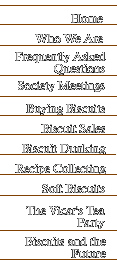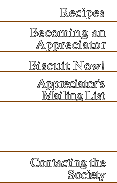 |
||
 |
||
 |
||
You may think that buying biscuits is an ordinary and trivial task. Well, think again - we aim to may you think twice before just picking any packet of biscuits off the supermarket shelf.Knowing your biscuit:
How much do you know about the biscuit you are considering buying?Do you know whether it is imported?
Many imported biscuits have often been subjected to tampering with toothpicks and other such implements. According to our sources at Rank Imports Ltd, many a biscuit has been tampered with before it reaches its final destination. This reached the very heart of the biscuit appreciation society, and we immediately started a world wide investigation. This investigation is still continuing, however, at this point we can only speculate as to how many biscuits have had to endure unduly tampering.Do you know the batch number of your biscuit?
A member of the biscuit appreciation organisation recently set off from London on a day excursion to Seattle. On visiting a tourist shop, he discovered a tourist biscuit set. The set was typical, with engraved names of the local towns and important sights. Upon further inspection, however, she discovered that not only was one of the biscuits a shade lighter than the rest, but the batch number was incredibly high. This may seem unimportant to many citizens, but to a member of the biscuit appreciation organisation, it was just another home truth of the sheer commercialisation of biscuits today. In laymen's terms, a high batch number means that there have been a large amount of that particular biscuit manufactured. Although we should point out that this isn't always the case: it has been found on some occasions, that the manufacturers have "fiddled" batch numbers in order to make it look as if the biscuit is very popular, when in fact it has not been the case.Do you know the preference of your biscuit?
Whilst this may seem a strange question, it is in fact a very common one amongst biscuit appreciators alike. Some biscuits are simply made for eating with no other condiments, whilst others are designed for what is commonly known as "dunking". "Dunking" is a very common practice amongst the lower and working class of Britain (also see the Vicars' Tea Party section of the web site), although unduly frowned upon by members of the middle and upper class. We at the biscuit appreciation organisation do not frown upon this activity: in fact we encourage it to a certain extent. Simply put, some biscuits were made for dunking. Some of our members have had the exciting opportunity to look at the manufacturers' specifications for some of the leading biscuits. In some cases, the specification clearly marks the biscuit for "DUNKING", whilst others are more subdued with the fact. Dunking is discussed in more detail in the "Biscuits for dunking" section of this web site.Do you know the sell by date of your biscuit?
This is possibly the most common thing to check with the casual biscuit purchaser, and it is also one of the most important - although for reasons that many may not have yet even considered. A biscuit confectioner, such as a member of the biscuit organisation, knows only too well that a biscuit or packet of, with a long sell-by date is a must. Not only because it means that the biscuit is more likely to taste fresher upon packet entry (as it is called amongst the trade), but because biscuits are unlike fine wines. A connoisseur of biscuits knows that a good quality biscuit should be enjoyed slowly, not devoured in the least time possible. Therefore, a long sell/use-by date is essential.
![]()